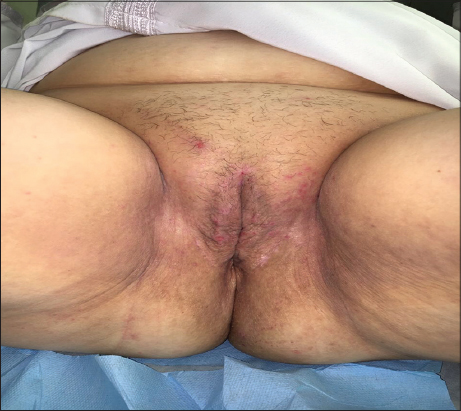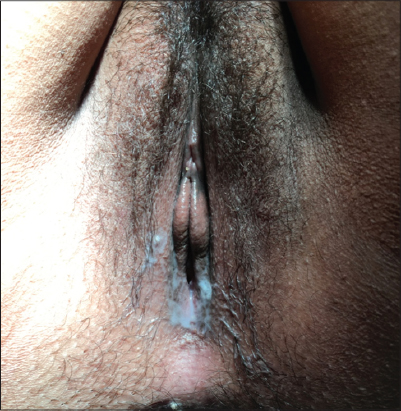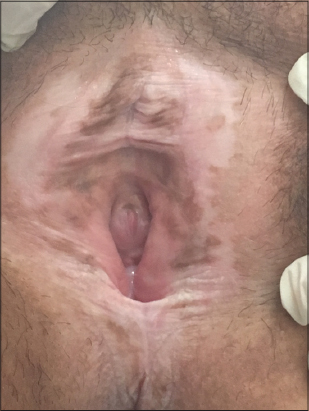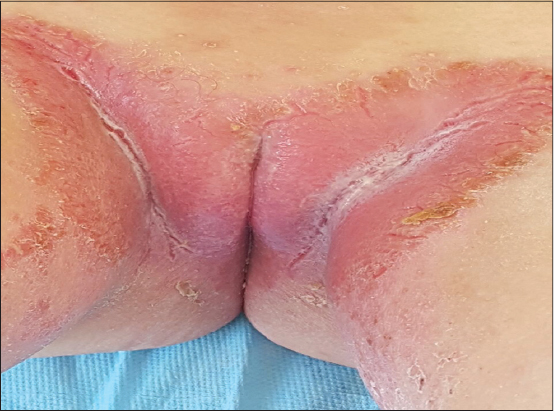Vulvar pruritus: A view over a life
Aicha Nassiri , Kaoutar Moustaide, Sara Elloudi, Hanane Baybay, Fatima Zahra Mernissi
, Kaoutar Moustaide, Sara Elloudi, Hanane Baybay, Fatima Zahra Mernissi
Department of Dermatology, Hassan II University Hospital Center, Fes, Morocco
Corresponding author: Dr. Aicha Nassiri, E-mail: aichanassiri6@gmail.com
Submission: 13.03.2019; Acceptance: 25.05.2019
DOI: 10.7241/ourd.20202.23
Cite this article: Nassiri A, Moustaide K, Elloudi S, Baybay H, Mernissi FZ. Vulvar pruritus: A view over a life. Our Dermatol Online. 2020;11(2):191-193.
Citation tools:
Copyright information
© Our Dermatology Online 2020. No commercial re-use. See rights and permissions. Published by Our Dermatology Online.
Sir,
Vulvar pruritus is a frequent reason for consultation. patients may not show signs of primary vulvar dermatosis (Fig. 1). Sensitivity to allergic contact is an important factor in these patients but can also occur as a secondary event in women with vulvar dermatoses.
 |
Figure 1: Excoriation in vulvar pruritus. |
Prospective study extending from April 2015 to April 2017 to recruit all patients whose reason for consultation is vulvar pruritus. We analyzed the causes in general and then according to age, evolutivity and treatment.
87 patients were identified. The age of patients ranged from 05 to 62 years (mean 39 years) and the duration of the disease was 0.5 to 36 months. The most common causes of acute vulvar pruritus are candidiasis 35%, (Fig. 2) contact dermatitis 38% in women of childbearing age, and oxyurids in small girls 20%. Chronic lichen simplex 13% (Fig. 3) is the most common cause of chronic vulvar pruritus, especially in postmenopausal women, followed by psoriasis (Fig. 4), Bowen disease (Fig. 5) and epidermoid carcinoma (Fig. 6). The symptomatic and etiological treatment was instituted. Evolution was marked in acute vulvar pruritus by rapid resolution. In contrast to patients with chronic pruritus, who were resistant to treatment in 40% of cases, and required very close follow-up.
 |
Figure 2: Vulvar candidoses. |
 |
Figure 3: Lichen sclerosus. |
 |
Figure 4: Vulvar psoriasis. |
 |
Figure 5: Vulvar Bowen disease. |
 |
Figure 6: Epidermoid carcinoma of the vulva. |
Pruritus is the most common symptom of vulvar disorders reported in the literature. The true prevalence of vulvar pruritus in the general female population in any given population is unknown, and so does itchig causes [1].
Vulvar pruritus can be caused by a wide range of diseases, which depend on age, environmental and genetic factors. In assessing vulvar pruritus, it is useful to group patients in a history of acute or chronic symptoms. Since infections are a common cause of acute pruritus, appropriate treatment should result in symptom control. A history of atopy can be very relevant because many patients with atopic dermatitis may have a pruritus disproportionate to all causes compared to the patient without atopy. Diabetic patients are more prone to bacterial and fungal infections involving wrinkles. The obese patients are also exposed for these infections, with wet sweat and occlusion as contributing factors.
The most common causes of acute vulvar pruritus are candidiasis, contact dermatitis in women of childbearing age, and oophorosis in young girls. Chronic lichen simplex is the most common cause of chronic vulvar pruritus, especially in postmenopausal women [2].
The causes of vulvar pruritus can often be multifactorial, but with careful evaluation, a primary diagnosis can be reached in most cases. A good history is necessary because patients feel uncomfortable discussing their problems and can not disclose self-applied remedies. Care should be taken during the examination because vulvar rashes may be subtle. All post-pubertal patients should benefit from vaginal sampling to diagnose candidiasis rather than treat empirically [3].
A wide range of therapies responds to vulvar pruritus, but it depends on the etiology and duration of evolution.
This article has attempted to summarize the various causes of vulvar pruritus and present a framework for evaluating these patients. Although not all patients have a readily classifiable disorder, symptomatic treatment and reassurance can provide considerable patient relief. There is no easy answer, yet the recognition that the process is treatable, if not curable, should provide encouragement for both patients and their physicians.
Consent
The examination of the patient was conducted according to the Declaration of Helsinki principles.
REFERENCES
1. Bohl TG. Overview of Vulvar Pruritus Through the Life Cycle. Clin Obstet Gynecol. 2005;48:786-807.
2. Kaur J, Kalsy J. Study of pruritus vulvae in geriatric age group in tertiary hospital. Indian J Sex Transm Dis AIDS. 2017;38:15-21.
3. Carrillo-Meléndrez H, Villamil-Cerda D, Espinoza-Hernández J, Lacy-Niebla RM. Vulvar pruritus:determination of the most common causes and their treatments]. Ginecol Obstet Mex. 2015;83:179-88.
Notes
Source of Support: Nil.
Conflict of Interest: None declared.
Request permissions
If you wish to reuse any or all of this article please use the e-mail (brzezoo77@yahoo.com) to contact with publisher.
| Related Articles | Search Authors in |
|
 http://orcid.org/000-0003-3455-3810 http://orcid.org/000-0003-3455-3810 |



Comments are closed.